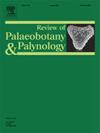Late Holocene palsa formation in northern Fennoscandia: Fossil pollen indication and climatic trigger
IF 1.7
3区 地球科学
Q2 PALEONTOLOGY
引用次数: 0
Abstract
Palsa is a peat mound with a permanently frozen core, occurring in the (sub)polar zone. So far, the history of European palsa mires has been investigated mainly by means of analysis of plant macroremains. To better understand how the formation of palsa is reflected in pollen records, we investigated fossil pollen of two sites in northern Fennoscandia: a conical palsa close to Abisko National Park (NW Sweden) and low palsa mire close to Nikel, Kola Peninsula (NW Russia).
At both sites, the formation of palsa is demonstrated by the same pattern in pollen record: decrease of Cyperaceae pollen and Pteridophyta and Lycopodiophyta spores, and the associated increase of ericoid dwarf shrubs and Rubus chamaemorus pollen. This pattern represents the change from a wet fen to a dry bog plant community after the uplift of the palsa mound above the surrounding terrain.
The age of both palsas formation around 2370 cal BP (Abisko) and 2270 cal BP (Nikel) falls in the two main periods of palsa initiation in Europe and thus represents further evidence of significant cooling in the period 2600–2100 cal BP. At both investigated sites, this cooling is also reflected by the decline of pine and the expansion of birch tundra.
Besides new original data, we provide an overview of so-far dated palsa formation in northern Fennoscandia and an interpretative key for identifying palsa in the palaeoecological record, based on plant species typical of the different stages of palsa development.
芬诺斯坎迪亚北部晚全新世palsa的形成:化石花粉指示和气候触发
帕尔萨是一个泥炭丘,核心永久冻结,发生在(亚)极地。迄今为止,研究欧洲palsa mires的历史主要是通过对植物大遗骸的分析。为了更好地了解palsa的形成如何反映在花粉记录中,我们研究了Fennoscandia北部两个地点的化石花粉:靠近Abisko国家公园(NW瑞典)的锥形palsa和靠近Nikel, Kola半岛(NW俄罗斯)的低palsa沼泽。两个地点的花粉记录均显示出相同的格局,即苏科花粉、蕨类植物和石松类植物的孢子减少,而石竹类矮灌木和石竹的花粉增加。这一模式代表了在palsa丘隆起高于周围地形后,从一个潮湿的沼泽植物群落到一个干燥的沼泽植物群落的变化。在2370 cal BP (Abisko)和2270 cal BP (Nikel)前后,两个palsa形成的年龄落在欧洲palsa形成的两个主要时期,因此进一步证明了2600-2100 cal BP期间的显著冷却。在这两个被调查的地点,这种冷却也反映在松树的减少和桦树苔原的扩大上。除了新的原始资料外,我们还提供了迄今为止芬诺斯坎迪亚北部palsa形成的概况,并基于palsa发育不同阶段的典型植物物种,在古生态记录中提供了识别palsa的解释性关键。
本文章由计算机程序翻译,如有差异,请以英文原文为准。
求助全文
约1分钟内获得全文
求助全文
来源期刊
CiteScore
3.50
自引率
21.10%
发文量
149
审稿时长
6 months
期刊介绍:
The Review of Palaeobotany and Palynology is an international journal for articles in all fields of palaeobotany and palynology dealing with all groups, ranging from marine palynomorphs to higher land plants. Original contributions and comprehensive review papers should appeal to an international audience. Typical topics include but are not restricted to systematics, evolution, palaeobiology, palaeoecology, biostratigraphy, biochronology, palaeoclimatology, paleogeography, taphonomy, palaeoenvironmental reconstructions, vegetation history, and practical applications of palaeobotany and palynology, e.g. in coal and petroleum geology and archaeology. The journal especially encourages the publication of articles in which palaeobotany and palynology are applied for solving fundamental geological and biological problems as well as innovative and interdisciplinary approaches.

 求助内容:
求助内容: 应助结果提醒方式:
应助结果提醒方式:


